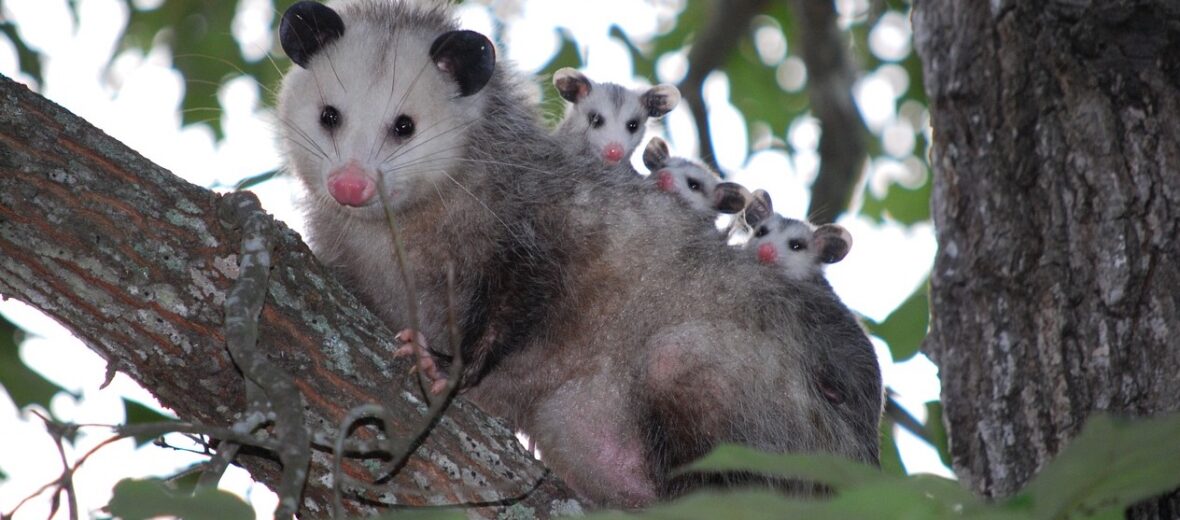
Often thought of as dumb, dirty animals who spread diseases like rabies, the opossum is one very misunderstood North American animal. The fact of the matter is opossums are cleaner, more intelligent, and more beneficial to humans than many realize. Sure they aren’t going to win any beauty contests, but they are hugely helpful to humans and even other animals. So, if you see one in your yard, give it some space and a little respect. They aren’t there to hurt you or your pets, they’re there to help.
First the Stats…
Scientific name: Didelphimorphia
Weight: Up to 14 lbs.
Length: Up to 37 inches
Lifespan: Up to 4 years
Now on to the Facts!
1.) Possums don’t have any control over when they “play dead” or for how long they do it. This comatose-like instance is an involuntary reaction caused by extreme stress. A similar anomaly occurs in fainting goats. It is a condition called myotonia congenita.
2.) When they pass out, they also excrete a putrid odor from their anal glands that helps ward off even the most persistent attacker(s).
3.) Opossums are the only marsupials (mom carries her babies in a pouch) located north of Mexico.
4.) Even though they are both marsupials, possums and opossums are actually different animals. opossums live in the Americas whereas possums live in Australia. American opossums typically lose out to Australian possums in the beauty contest arena too.
5.) In a series of obstacle courses, opossums were able to locate food better than cats, dogs, rats, and even pigs. They are also able to remember the smell of toxins found in food up to a year after trying them.
But wait, there’s more on the opossum!
6.) They eat snakes too. These critters are immune to all snake venom in North America, except the coral snake. So they have no trouble taking out venomous snakes from your yard.
7.) Even though they aren’t totally immune to the virus, it’s very hard to find one with rabies. Marsupials like possums have a lower body temperature than regular placental mammals that live in North America. Basically, their bodies don’t provide the right environment for the virus.
Did you know…?
According to the NWF (National Wildlife Federation), a single possum eats up to 5,000 ticks each season! So, if you have an opossum in your yard, you stand less of a chance of finding these blood sucking parasites on your property.
8.) Their tails are prehensile and they act as a 5th appendage when climbing trees. They also have opposable thumbs on their hind feet.
9.) American opossums are nearly as clean as house cats. They constantly groom themselves with their paws and tongue and are able to pick off around 90% of ticks that may happen upon their person. They are also almost totally odorless, except when they feign death and release their wonderful musk of doom.
10.) Even though their eyes look totally black, they do have a white sclera. It’s just that the pupils are so large, as to let in more light at night, that it looks as though their eyes are all black.
But wait, there’s still more on the opossum!
11.) Opossums eat carrion (dead animals), small invertebrates, small reptiles, amphibians, insects, garbage, eggs, fruits, berries, and of course ticks; lots and lots of ticks.
12.) Females have two vaginal tracts and two uteri, and males have a forked or bifurcated penis. This is not unusual for marsupials though.
13.) Between October – January, opossums breed and give birth to up to 2 litters of up to 20 joeys. The gestation period of an opossum is about 13 days, after which time the joeys are born and must immediately locate and attach to 1 of mom’s 13 nipples inside her pouch. If more joeys are born than mom has nipples to go around, the additional babies will starve to death.
Now a Short Opossum Video!
Also, check out the Critter Science YouTube channel. Videos added frequently!
Want to suggest a critter for me to write about? Let me know here.



